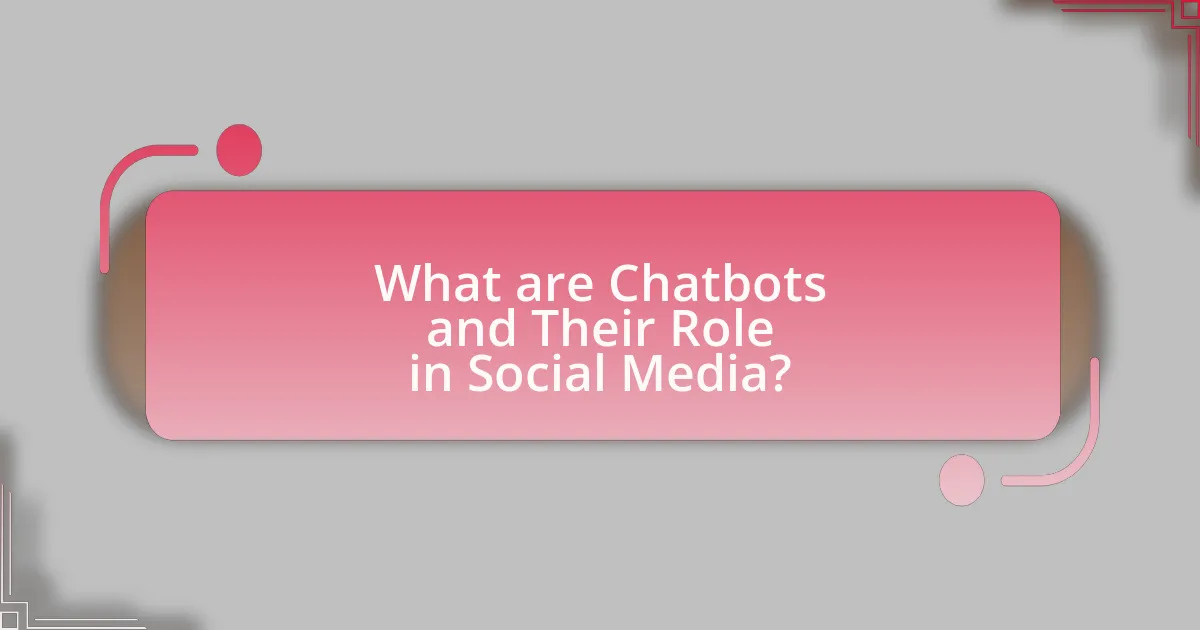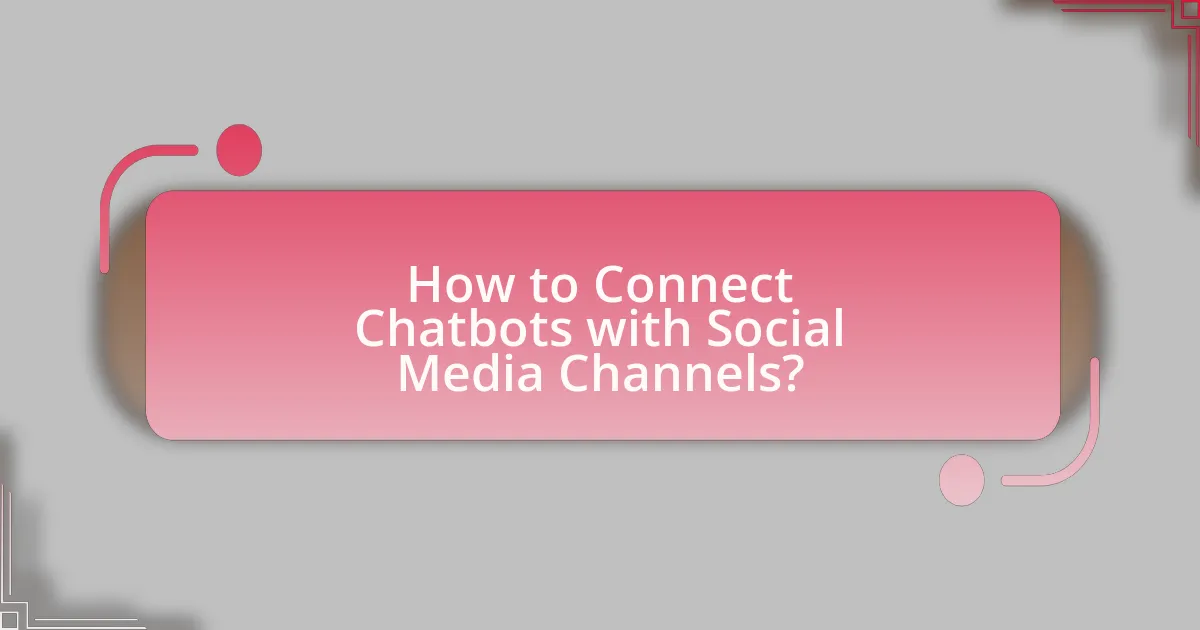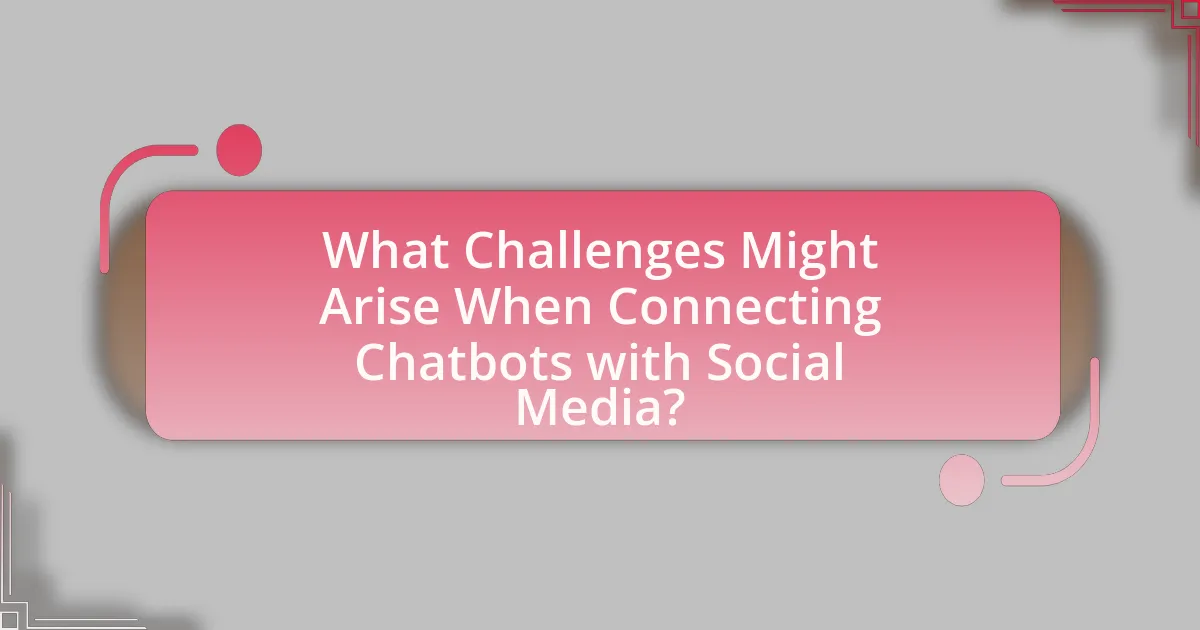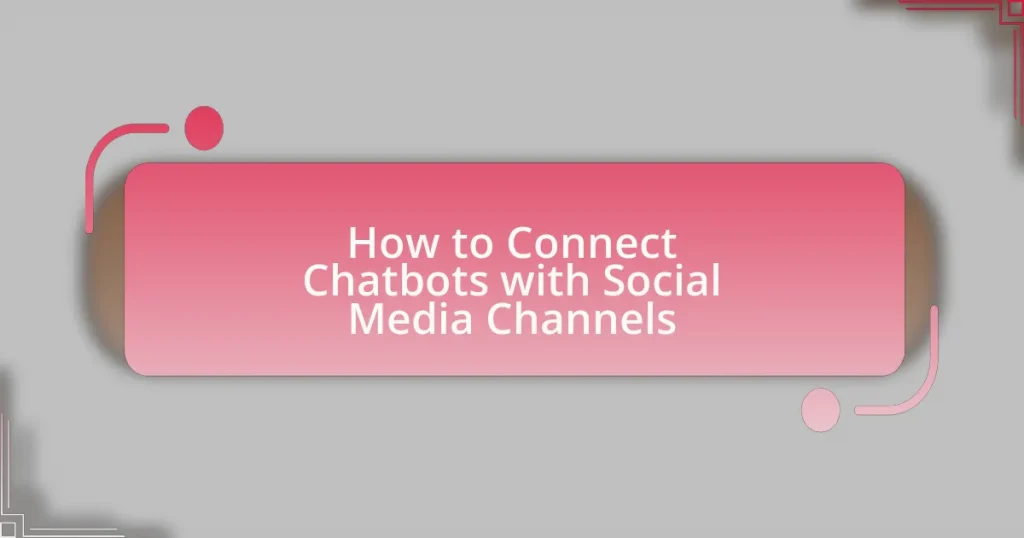Chatbots are automated software applications that simulate human conversation, playing a vital role in enhancing customer engagement on social media platforms. This article explores how to connect chatbots with social media channels, detailing the technologies that enable their functionality, the steps for integration, and best practices for optimizing performance. It also addresses the challenges and limitations faced during integration, as well as methods for measuring success and improving chatbot functionality through user feedback. Key metrics for evaluating chatbot performance and practical tips for enhancing user experience are also discussed, providing a comprehensive guide for businesses looking to leverage chatbots in their social media strategies.

What are Chatbots and Their Role in Social Media?
Chatbots are automated software applications designed to simulate human conversation, primarily through text or voice interactions. In social media, chatbots play a crucial role by enhancing customer engagement, providing instant responses to inquiries, and facilitating seamless communication between brands and users. For instance, according to a report by Business Insider, 80% of businesses plan to use chatbots by 2024, highlighting their growing importance in social media strategies. Chatbots can handle multiple queries simultaneously, reducing response times and improving user satisfaction, which is essential for maintaining a competitive edge in the digital landscape.
How do chatbots function within social media platforms?
Chatbots function within social media platforms by automating interactions between users and businesses, providing instant responses to inquiries and facilitating customer service. These chatbots utilize natural language processing (NLP) to understand user queries and deliver relevant information or assistance, enhancing user engagement and satisfaction. For instance, Facebook Messenger supports chatbot integration, allowing businesses to respond to customer messages 24/7, which can lead to increased sales and improved customer loyalty. According to a report by Business Insider, 80% of businesses plan to use chatbots by 2024, highlighting their growing importance in social media interactions.
What technologies enable chatbot functionality on social media?
Chatbot functionality on social media is enabled by several key technologies, including Natural Language Processing (NLP), machine learning algorithms, and application programming interfaces (APIs). NLP allows chatbots to understand and interpret user inputs in natural language, facilitating meaningful interactions. Machine learning algorithms enhance the chatbot’s ability to learn from user interactions, improving response accuracy over time. APIs enable seamless integration of chatbots with social media platforms, allowing them to send and receive messages, access user data, and perform actions within the social media environment. These technologies collectively empower chatbots to provide efficient and engaging user experiences on social media channels.
How do chatbots interact with users on social media?
Chatbots interact with users on social media by utilizing natural language processing to understand and respond to user inquiries in real-time. These automated systems can engage in conversations, answer questions, provide customer support, and facilitate transactions directly within social media platforms. For instance, Facebook Messenger chatbots can handle thousands of inquiries simultaneously, allowing businesses to maintain high levels of customer engagement without the need for human intervention. According to a report by Business Insider, 80% of businesses plan to use chatbots by 2022, highlighting their growing importance in social media interactions.
Why are chatbots important for social media engagement?
Chatbots are important for social media engagement because they provide instant responses and enhance user interaction. By utilizing chatbots, brands can engage with their audience 24/7, addressing inquiries and providing support without delays. According to a study by HubSpot, 71% of consumers expect to be able to connect with brands through social media, and chatbots facilitate this connection by automating responses and personalizing interactions. This leads to increased customer satisfaction and loyalty, as users receive timely assistance and relevant information tailored to their needs.
What advantages do chatbots provide for businesses on social media?
Chatbots provide businesses on social media with enhanced customer engagement and operational efficiency. They enable 24/7 customer support, allowing businesses to respond to inquiries instantly, which can lead to higher customer satisfaction rates. According to a study by Juniper Research, chatbots can save businesses up to $8 billion annually by 2022 through reduced operational costs. Additionally, chatbots can handle multiple interactions simultaneously, increasing the capacity for customer service without the need for additional staff. This scalability allows businesses to manage high volumes of inquiries during peak times effectively.
How do chatbots enhance customer experience on social media?
Chatbots enhance customer experience on social media by providing instant responses and personalized interactions. They enable brands to engage with customers 24/7, addressing inquiries and resolving issues without delay. According to a study by HubSpot, 71% of consumers expect companies to provide customer service via social media, and chatbots fulfill this expectation by automating responses to frequently asked questions, thus improving efficiency. Additionally, chatbots can analyze user data to tailor recommendations and offers, further enhancing the customer experience by making interactions more relevant and engaging.

How to Connect Chatbots with Social Media Channels?
To connect chatbots with social media channels, developers must utilize the APIs provided by the respective social media platforms. For instance, Facebook Messenger offers a Messenger Platform API that allows chatbots to send and receive messages, while Twitter provides a Direct Message API for similar functionalities. By integrating these APIs into the chatbot’s backend, developers can facilitate real-time communication between users and the chatbot on social media. This integration is validated by the fact that over 1.3 billion users engage with chatbots on platforms like Facebook Messenger, demonstrating the effectiveness of such connections in enhancing user interaction.
What are the steps to integrate chatbots with social media platforms?
To integrate chatbots with social media platforms, follow these steps: First, select the social media platform where the chatbot will be deployed, such as Facebook Messenger or WhatsApp. Next, create a developer account on the chosen platform to access their API. After that, design the chatbot’s conversation flow and functionalities using a chatbot development framework or platform, such as Dialogflow or Microsoft Bot Framework. Then, connect the chatbot to the social media platform using the provided API, ensuring to authenticate the connection with the necessary tokens or keys. Finally, test the chatbot thoroughly on the social media platform to ensure it functions as intended and meets user needs.
How do you choose the right social media platform for chatbot integration?
To choose the right social media platform for chatbot integration, assess the target audience and platform demographics. For instance, Facebook has over 2.9 billion monthly active users, making it ideal for broad reach, while platforms like LinkedIn cater to professionals, suitable for B2B interactions. Additionally, consider the platform’s API capabilities and integration ease; for example, WhatsApp offers a Business API that facilitates seamless chatbot deployment. Analyzing user engagement metrics on each platform can further guide the decision, as higher interaction rates indicate a more suitable environment for chatbot functionality.
What tools and software are available for chatbot integration?
Several tools and software are available for chatbot integration, including Dialogflow, Microsoft Bot Framework, and Chatfuel. Dialogflow, developed by Google, allows developers to create conversational interfaces and integrates seamlessly with various platforms like Facebook Messenger and Slack. Microsoft Bot Framework provides a comprehensive environment for building and connecting intelligent bots to multiple channels, including Skype and Teams. Chatfuel is a user-friendly platform specifically designed for Facebook Messenger, enabling users to create chatbots without coding. These tools facilitate the integration of chatbots into social media channels, enhancing user engagement and interaction.
What are the best practices for connecting chatbots to social media?
The best practices for connecting chatbots to social media include ensuring seamless integration, maintaining user privacy, and providing clear user guidance. Seamless integration allows chatbots to operate smoothly across platforms like Facebook Messenger and WhatsApp, enhancing user experience. Maintaining user privacy is crucial; compliance with regulations such as GDPR ensures that user data is handled responsibly. Providing clear user guidance helps users understand how to interact with the chatbot effectively, which can increase engagement and satisfaction. These practices are supported by studies indicating that user-friendly interfaces and privacy compliance significantly improve user trust and interaction rates with chatbots on social media platforms.
How can you ensure seamless communication between chatbots and users?
To ensure seamless communication between chatbots and users, implement natural language processing (NLP) capabilities that allow the chatbot to understand and respond to user queries effectively. NLP enables chatbots to interpret user intent, manage context, and generate human-like responses, which enhances user experience. For instance, a study by McTear (2017) highlights that chatbots equipped with advanced NLP can achieve up to 90% accuracy in understanding user inputs, significantly improving interaction quality. Additionally, integrating user feedback mechanisms allows continuous learning and adaptation, further refining communication effectiveness.
What common mistakes should be avoided during integration?
Common mistakes to avoid during integration of chatbots with social media channels include inadequate testing, overlooking user experience, and failing to ensure data security. Inadequate testing can lead to functionality issues, as evidenced by a study from the Nielsen Norman Group, which found that 70% of users abandon a task due to poor usability. Overlooking user experience can result in low engagement rates; research by HubSpot indicates that 76% of users expect a seamless interaction with chatbots. Lastly, failing to ensure data security can expose sensitive information, with a report from IBM stating that the average cost of a data breach is $3.86 million.

What Challenges Might Arise When Connecting Chatbots with Social Media?
Connecting chatbots with social media can lead to several challenges, including integration complexities, data privacy concerns, and user experience issues. Integration complexities arise due to the diverse APIs and platforms that social media channels utilize, which can complicate the seamless functioning of chatbots. Data privacy concerns are significant, as chatbots must comply with regulations like GDPR while handling user data, potentially limiting their functionality. User experience issues may occur if chatbots fail to understand context or provide relevant responses, leading to frustration among users. These challenges highlight the need for careful planning and execution when integrating chatbots with social media platforms.
What technical issues can occur during chatbot integration?
Technical issues during chatbot integration can include API compatibility problems, data synchronization errors, and security vulnerabilities. API compatibility issues arise when the chatbot’s programming interface does not align with the social media platform’s requirements, leading to failed connections. Data synchronization errors can occur when user data is not accurately shared between the chatbot and the social media channel, resulting in inconsistent user experiences. Security vulnerabilities may arise if proper authentication and encryption measures are not implemented, exposing sensitive user information. These issues can significantly hinder the effectiveness of chatbot integration with social media channels.
How can you troubleshoot connectivity problems?
To troubleshoot connectivity problems, first check the physical connections, ensuring that all cables are securely plugged in and that devices are powered on. Next, verify the network settings on the device, including IP address and DNS configurations, to ensure they are correctly set. Additionally, restart the router and modem to refresh the connection, as this can resolve many common issues. If problems persist, run a network diagnostic tool to identify specific issues, and consult the device’s user manual or support resources for further guidance. These steps are effective because they address the most common causes of connectivity issues, such as hardware malfunctions or incorrect settings.
What are the limitations of chatbots on social media platforms?
Chatbots on social media platforms face several limitations, including their inability to understand complex human emotions and context. This limitation often leads to misinterpretations of user queries, resulting in unsatisfactory responses. Additionally, chatbots struggle with handling nuanced conversations, which can frustrate users seeking personalized interactions. According to a study by the Pew Research Center, 60% of users reported that chatbots often fail to provide the information they need, highlighting their inadequacy in addressing diverse user needs. Furthermore, chatbots are limited by their programming, which restricts their ability to learn from interactions in real-time, making them less adaptable compared to human agents.
How can you measure the success of chatbot integration on social media?
To measure the success of chatbot integration on social media, track key performance indicators (KPIs) such as user engagement, response time, and conversion rates. User engagement can be assessed through metrics like the number of interactions, session duration, and user feedback ratings. Response time is critical, as faster responses typically correlate with higher user satisfaction. Conversion rates, which indicate the percentage of users completing desired actions (like making a purchase or signing up for a newsletter), provide direct insight into the chatbot’s effectiveness in achieving business goals. According to a study by Juniper Research, chatbots are expected to save businesses over $8 billion annually by 2022, highlighting their potential impact on operational efficiency and customer satisfaction.
What metrics should be tracked to evaluate chatbot performance?
To evaluate chatbot performance, key metrics to track include user engagement, response accuracy, conversation completion rate, and customer satisfaction scores. User engagement measures how often users interact with the chatbot, indicating its effectiveness in capturing attention. Response accuracy assesses the chatbot’s ability to provide correct answers, which is crucial for user trust. The conversation completion rate reflects the percentage of interactions that lead to successful outcomes, demonstrating the chatbot’s efficiency. Customer satisfaction scores, often gathered through post-interaction surveys, provide direct feedback on user experience and satisfaction levels. These metrics collectively offer a comprehensive view of chatbot performance and areas for improvement.
How can user feedback improve chatbot functionality on social media?
User feedback can significantly enhance chatbot functionality on social media by providing insights into user preferences and pain points. This feedback allows developers to identify common issues, improve response accuracy, and tailor interactions to better meet user needs. For instance, a study by the Journal of Human-Computer Interaction found that chatbots that adapt based on user feedback can increase user satisfaction by up to 30%. By continuously integrating user suggestions and complaints, chatbots can evolve to offer more relevant and efficient services, ultimately leading to improved user engagement and retention on social media platforms.
What are some practical tips for optimizing chatbot performance on social media?
To optimize chatbot performance on social media, implement the following practical tips: First, ensure the chatbot is trained on relevant FAQs and user intents to provide accurate responses. This training can significantly enhance user satisfaction, as studies show that well-trained chatbots can resolve up to 80% of common inquiries without human intervention. Second, integrate the chatbot with social media analytics tools to monitor user interactions and feedback, allowing for continuous improvement based on real-time data. Research indicates that businesses using analytics to refine chatbot interactions see a 30% increase in engagement rates. Third, personalize interactions by using user data to tailor responses, which can lead to a 20% increase in user retention. Lastly, regularly update the chatbot’s knowledge base to include new products, services, or features, ensuring it remains relevant and useful to users.










